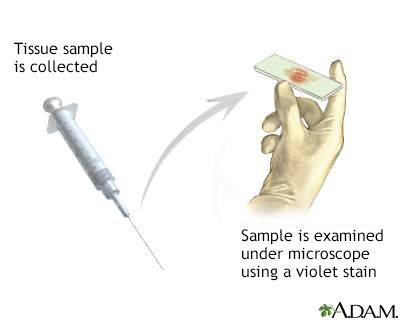Gram stain of tissue biopsy
Definition
Gram stain of tissue biopsy test involves using crystal violet stain to test a sample of tissue taken from a biopsy.
The Gram stain method can be used on almost any specimen. It is an excellent technique for making a general, basic identification of the type of bacteria in the sample.
Alternative Names
Tissue biopsy - Gram stain
How the Test is Performed
A sample, called a smear, from a tissue specimen is placed in a very thin layer on a microscope slide. The specimen is stained with crystal violet stain and goes through more processing before it is examined under the microscope for bacteria.
Characteristic appearance of the bacteria, such as their color, shape, clustering (if any), and pattern of staining help determine the type of bacteria.
How to Prepare for the Test
If the biopsy is included as part of a surgical procedure, you will be asked not to eat or drink anything the night before surgery. If the biopsy is of a superficial (on the surface of the body) tissue, you may be asked not to eat or drink for several hours before the procedure.
How the Test will Feel
How the test feels depends on the part of the body being biopsied. There are several different methods for taking tissue samples.
- A needle may be inserted through the skin to the tissue.
- A cut (incision) through the skin into the tissue may be made, and a small piece of the tissue removed.
- A biopsy may also be taken from inside the body using an instrument that helps the doctor see inside the body, such as an endoscope or cystoscope.
You may feel pressure and mild pain during a biopsy. Some form of pain-relieving medicine (anesthetic) is usually given, so you have little or no pain.
Why the Test is Performed
The test is performed when an infection of a body tissue is suspected.
Normal Results
Whether there are bacteria, and what type there are, depends on the tissue being biopsied. Some tissues in the body are sterile, such as the brain. Other tissues, such as the gut, normally contain bacteria.
Note: Normal value ranges may vary slightly among different laboratories. Talk to your doctor about the meaning of your specific test results.
What Abnormal Results Mean
Abnormal results usually mean there is an infection in the tissue. More tests, such as culturing the tissue that was removed, are often needed to identify the type of bacteria.
Risks
Risks depend on the procedure used to take the tissue biopsy, and may include bleeding or infection.
Gallery

References
Chernecky CC, Berger BJ. Biopsy, site-specific - specimen. In: Chernecky CC, Berger BJ, eds. Laboratory Tests and Diagnostic Procedures. 6th ed. St Louis, MO: Elsevier Saunders; 2013.199-202.
Hall GS, Woods GL. Medical bacteriology. In: McPherson RA, Pincus MR, eds. Henry's Clinical Diagnosis and Management by Laboratory Methods. 23rd ed. St Louis, MO: Elsevier; 2017:chap 58.